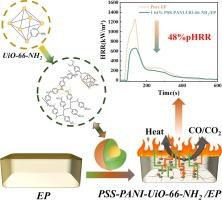High fire-safety epoxy resin with functional polymer/metal–organic framework hybrids
IF 5.8
2区 化学
Q1 POLYMER SCIENCE
引用次数: 0
Abstract
Petroleum-derived bisphenol A-type epoxy resins are highly flammable and vulnerable to fires, limiting their wide applications. The addition of inorganic flame retardants to the epoxy resin improves the flame retardancy of the epoxy resin, but it is difficult to distribute them evenly in the polymer matrix. Here, we introduce flame-retardant epoxy resins supported by the functional polymer/metal–organic framework hybrids. The hybrids, consisted of polyaniline, poly (4-styrenesulfonic acid), and Zr-based organic frameworks, demonstrate effective flame-retardant effects with homogeneous distribution in the epoxy based on their synergistic effects of each material. Compared with pure epoxy resin, the presence of 1 wt% of hybrid flam-retardant remarkably decreases the combustion, the heat release, and the smoke production.

含功能聚合物/金属有机框架杂化物的高防火安全性环氧树脂
从石油中提取的双酚 A 型环氧树脂极易燃烧,容易引发火灾,因此限制了其广泛应用。在环氧树脂中添加无机阻燃剂可提高环氧树脂的阻燃性,但很难将其均匀分布在聚合物基体中。在此,我们介绍了由功能聚合物/金属有机框架杂化物支撑的阻燃环氧树脂。这些杂化物由聚苯胺、聚(4-苯乙烯磺酸)和锆基有机框架组成,基于每种材料的协同作用,它们在环氧树脂中均匀分布,表现出有效的阻燃效果。与纯环氧树脂相比,1 wt%的混合阻燃剂可显著减少燃烧、热释放和烟雾产生。
本文章由计算机程序翻译,如有差异,请以英文原文为准。
求助全文
约1分钟内获得全文
求助全文
来源期刊

European Polymer Journal
化学-高分子科学
CiteScore
9.90
自引率
10.00%
发文量
691
审稿时长
23 days
期刊介绍:
European Polymer Journal is dedicated to publishing work on fundamental and applied polymer chemistry and macromolecular materials. The journal covers all aspects of polymer synthesis, including polymerization mechanisms and chemical functional transformations, with a focus on novel polymers and the relationships between molecular structure and polymer properties. In addition, we welcome submissions on bio-based or renewable polymers, stimuli-responsive systems and polymer bio-hybrids. European Polymer Journal also publishes research on the biomedical application of polymers, including drug delivery and regenerative medicine. The main scope is covered but not limited to the following core research areas:
Polymer synthesis and functionalization
• Novel synthetic routes for polymerization, functional modification, controlled/living polymerization and precision polymers.
Stimuli-responsive polymers
• Including shape memory and self-healing polymers.
Supramolecular polymers and self-assembly
• Molecular recognition and higher order polymer structures.
Renewable and sustainable polymers
• Bio-based, biodegradable and anti-microbial polymers and polymeric bio-nanocomposites.
Polymers at interfaces and surfaces
• Chemistry and engineering of surfaces with biological relevance, including patterning, antifouling polymers and polymers for membrane applications.
Biomedical applications and nanomedicine
• Polymers for regenerative medicine, drug delivery molecular release and gene therapy
The scope of European Polymer Journal no longer includes Polymer Physics.
 求助内容:
求助内容: 应助结果提醒方式:
应助结果提醒方式:


